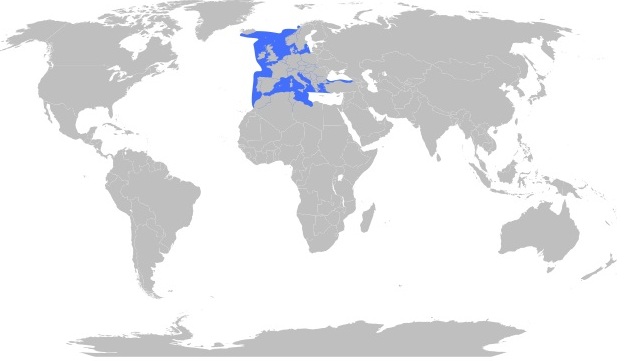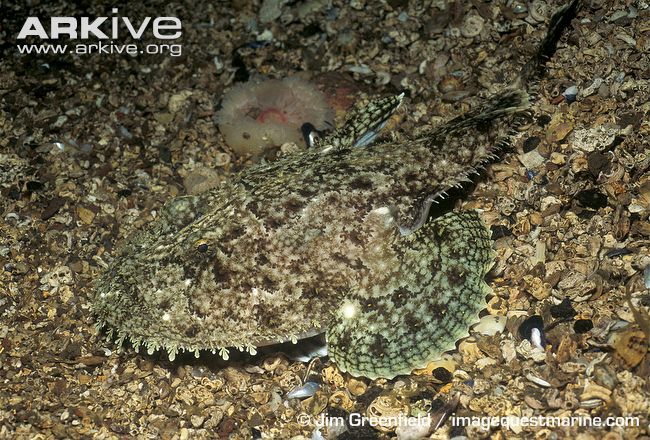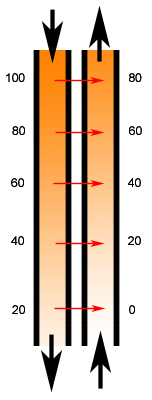Places to Stay Away From if You Are Any Other Species of Fish
Lophius piscatorius can be found in the
Mediterranean, Black and Eastern Atlantic Seas (FAO 2012).
 These areas are
highlighted in blue on the map below. The Anglerfish enjoys
dwelling at the bottom of the ocean often living at depths of
well over 1500 feet (Linnaeus 1758). Along with adapting to the
high pressure present in the depths of the ocean, the anglerfish
has evolved many unique adjustments to its environment giving
it advantages in dominating the food chain and warding off
predators.
These areas are
highlighted in blue on the map below. The Anglerfish enjoys
dwelling at the bottom of the ocean often living at depths of
well over 1500 feet (Linnaeus 1758). Along with adapting to the
high pressure present in the depths of the ocean, the anglerfish
has evolved many unique adjustments to its environment giving
it advantages in dominating the food chain and warding off
predators.
The depth at which an anglerfish is found is highly correlated with the stage of life the fish is in. As it is growing, L. piscatorious develops from juvenile to adult in shallower waters on soft beds (AdriaMed 2012). Once it matures into a spawning period the anglerfish migrates into deeper sea waters where it is safer to release its larvae (Ungaro et. al. 2002).
The benthic life strategy of the fish is a very clever
adaption. Living in sandy beds with pale
 sand-colored skin helps
the anglerfish camouflage itself from prey and predators. The
anglerfish loosens the sediment with its thick, strong pelvic
fins and then scoops sand from underneath itself with its
flexible, fan-shaped pectoral fins. This digs the fish into sand
so it can lie more flatly further camouflaging its presence.
These morphological adaptations help to conceal the anglerfish
after a large meal. Along with an absence of ribs and
retractable jaws, the fish's expandable stomachs allow them to
ingest prey with a similar body size. Since they eat in large
portions, similar to many snakes, it takes their body awhile to
digest the gigantic feast they just consumed leaving them
vulnerable to predators (Laurenson et. al 2004). Although some
risk is involved, eating large meals is a great adaption for
deep sea organisms because food is so scarce (Rice 2010). These
morphological adaptations allow anglers a better survival rate
and a less stressful life.
sand-colored skin helps
the anglerfish camouflage itself from prey and predators. The
anglerfish loosens the sediment with its thick, strong pelvic
fins and then scoops sand from underneath itself with its
flexible, fan-shaped pectoral fins. This digs the fish into sand
so it can lie more flatly further camouflaging its presence.
These morphological adaptations help to conceal the anglerfish
after a large meal. Along with an absence of ribs and
retractable jaws, the fish's expandable stomachs allow them to
ingest prey with a similar body size. Since they eat in large
portions, similar to many snakes, it takes their body awhile to
digest the gigantic feast they just consumed leaving them
vulnerable to predators (Laurenson et. al 2004). Although some
risk is involved, eating large meals is a great adaption for
deep sea organisms because food is so scarce (Rice 2010). These
morphological adaptations allow anglers a better survival rate
and a less stressful life.
 Monkfish are not picky eaters. They are opportunistic
feeders that will munch on almost anything that comes their way.
This includes most fish in their surrounding area: cod, ling,
redfish and sometimes krill or barnacles. Detection of a prey
begins a response that causes the dorsal fin rays to become
stiff, slowed breathing rate, and the fishing rod to flick back
and forth, attracting a prey toward the opening of the
mouth. (Laurenson et. al. 2004)
Monkfish are not picky eaters. They are opportunistic
feeders that will munch on almost anything that comes their way.
This includes most fish in their surrounding area: cod, ling,
redfish and sometimes krill or barnacles. Detection of a prey
begins a response that causes the dorsal fin rays to become
stiff, slowed breathing rate, and the fishing rod to flick back
and forth, attracting a prey toward the opening of the
mouth. (Laurenson et. al. 2004)
Not only in slowed breathing, but all breathing done by an anglerfish is done through the process of counter current exchange(pictured to the right). The blood in the capillaries of the gills flows the opposite way of the water coming in. Because gases move from an area of higher concentration to an area of lower concentration, the high concentration of oxygen coming in from the water will diffuse quickly into the low concentration of blood in the capillaries. Since the blood and water are flowing counter currently with very different concentrations of gas, oxygen will diffuse more quickly and efficiently across the membrane than if the blood and water were moving in the same direction. After the blood is oxygenated it is distributed throughout the fish’s body (Campbell and Reece et. al 2009).
Another adaptation that allows the anglerfish to live in the depths of the ocean is its illicium, or fishing rod. Through a symbiotic relationship with a bioluminescent bacterium, L. piscatorius can better attract mates, prey, and scare off predators. It dangles its fishing rod in front of its mouth until it attracts a fish to eat (Rice 2010). If no fish swim by anglerfish often “walk” using their pelvic and pectoral fins to get closer to areas with more prey (Laurenson et. al. 2004). All these distinctive adaptations give the anglerfish a step above the rest- literally.
Next Page: Spooky Story
Return to the Homepage
